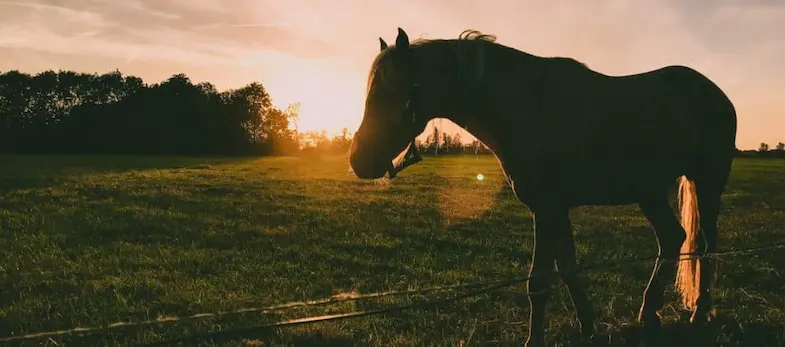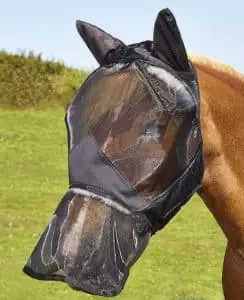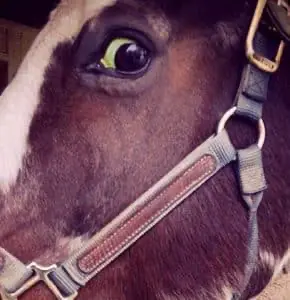You might not think that horses can suffer from sunburn but, while it is more common in grey horses, any horse can suffer to some extent and, contrary to popular believe, sunlight can be damaging all year round – although the risk of sunburn is at its greatest during the summer months. The good news is that it can easily be prevented but problems can arise with long term repeat exposure.
Photosensitivity, on the other hand, can be mistaken for sunburn, and while it often has the same symptoms it’s caused by too many reactive compounds (known as photosensitizers) in the horse’s tissue. In most cases though, if you remove the source of this then the problem will go away on its own.
What is sunburn?
Horses, like all animals, have pigments, known as melanin, in their skin that block the harmful ultraviolet rays from the sun. This is the same pigment that gives skin its color, but on areas of skin where there’s no color, there’s also no protection so these delicate areas are prone to ‘damage’ by the rays. This damage (or radiation as it technically is) is what we call sunburn.
While horses with gray coats, those with pinto coloring, or spotted horses are more susceptible any horse with white markings (such as a blaze or stockings) can suffer from sunburn, as can horses with thin coats. As you’d probably suspect the areas most likely to suffer from sunburn are the face, tips of the ears, the heals and any white areas such as the legs but horses can actually become sunburnt anywhere on their bodies, even their back.
If you’ve ever been burnt while on vacation you’ll know how sore and painful it can be and this is no different for horses which is why, if your horse has a sunburnt back, you shouldn’t ride him until his back is completely healed.
How to prevent sunburn in horses
Sunburn can happen at any time of year but during the summer the sun is higher in the sky which is when the rays are at their strongest and therefore can do more harm. This means that you need to take extra steps to protect your horse during these months.
It goes without saying that you should provide your horse with plenty of shade, either by using trees as natural shade or with a walk-in stall, where your horse can escape from the sun but you should also try and keep him out of the sun when it’s at its strongest. Some owners will keep their horses in during the day and then turn them out at night.
Fly or sun sheets that have been made with UV-resistant materials can block up to 70% of the harmful rays but because they’re made from meshes they can’t give your horse full protection from the sun. Masks can also offer some protection, especially ones such as Absorbine’s Fly Shield (which is available on Amazon) that covers the entire face, including the ears and nose.
You can also use a high-factor water-resistant sunblock or suncream to protect exposed and vulnerable areas. As your horse continually puts his head down to graze the sunblock will rub off on the plants so you’ll need to reapply from time to time. You can use a block that’s suitable for children or if you’d prefer, some equine sunblocks are available as brightly colored sticks, this will not only help you to make sure your horse is fully covered but it’ll also allow you to see when it needs to be replaced. If you do choose to use a child-safe sunblock though make sure it doesn’t contain PABA (or para-aminobenzoic acid) because many horses are sensitive to it and it can cause painful rashes.
If you’re not keen on using sunblock then zinc oxide is a great alternative, you can buy it as a cream and it has a two-fold benefit because as well as working to protect your horse it can also be used to heal skin that has already been burnt.
Treating sunburn in horses
Prevention is always better than cure but sometimes that just isn’t possible and if your horse is suffering from minor sunburn then you can apply something like zinc oxide, coconut oil, or an emollient cream to the affected areas. This will work to prevent infection but also help to soothe the skin and stop it itching.
If your horse’s skin has started to blister and ooze it’s better to seek medical advice, your veterinarian may advise that your horse needs a course of antibiotics.
What is photosensitivity?
Photosensitivity is severe dermatitis or skin inflammation that can be caused by digesting plants with reactive compounds (known as photosensitizers). While horses generally won’t eat these plants they can, and will, graze near them so their noses often come into contact with these photosensitizers, and therefore it can make them sore too.
Primary photosensitivity
Thankfully primary photosensitivity is generally very easy to deal with because all you need to do is remove the problem plants from the pasture and then treat the sore skin. Once you’ve eradicated the plants your horse will be safe to graze again without risk of photosensitivity.
Some of the more common plants that contain photosensitizers are:
- St. Johns Wort
- Buckwheat
- Buttercup
- Cow Parsley
- Perennial Ryegrass
- Whiteheads
- Ground elder
Secondary photosensitivity
Secondary photosensitivity is caused when the liver is severely damaged and can’t process chlorophyll properly. This means that the horse can’t dispose of the phylloerythrin properly (it’s normally removed via the horse’s droppings) and therefore there’s too much of it in the tissue. Phylloerythrin is accumulative and highly photosensitive so when the skin is exposed to ultraviolet rays it erupts and blisters.
The prognosis for secondary photosensitivity isn’t so good because by the time the liver is damaged enough to show the symptoms through the skin the chances of making a full recovery are much less. If you suspect your horse is suffering from this then it’s vitally important you speak to your veterinarian immediately, he’ll also be able to check the other horses because if your horse has eaten something toxic then its highly likely other horses have too.
Not all horses will show visible signs of secondary photosensitivity (around 25% will) so it’s important to recognize the first signs of liver damage. Most horses will lose body condition as well as their appetite but lethargy is also a symptom. Horses can become constipated or suffer diarrhea but any yellowing of the skin (known as jaundice) is a tell-tell sign of liver damage and is most visible around the eyes and inside the mouth.
One of the main causes of secondary photosensitivity is the digestion of plants containing pyrrolizidine alkaloids (PA) which are highly toxic, especially to the liver. These plants will often remain toxic even after being picked and dried but thankfully they taste very bitter. This taste means that horses won’t choose to eat them unless of course they’re really hungry and don’t have access to proper forage or other food. The most common plants to contain pyrrolizidine alkaloids are:
- Ragwort
- Alsike clover
- Red clover
- Tarweed
- Purple viper’s bugloss
- Houndstongue
- Rattlepod
- Gromwell
You can find a more definitive list on Wikipedia
How to prevent photosensitivity in horses
Both primary and secondary photosensitivity can easily be prevented by making sure that all pastures and grazing areas are free from all plants that contain photosensitizers but all, and more importantly, all plants containing pyrrolizidine alkaloids.
With regards to toxic plants though it’s important to remember that they can remain toxic for many months (if not years) after so make sure your hay supply isn’t contaminated with these plants. You can do this by buying from a reputable producer or, if you produce the hay yourself, making sure there are no toxic plants in the fields.
Treating photosensitivity in horses
If your horse is suffering from primary photosensitivity then it can be treated in much the same way as sunburn can, although it may also be advisable to bring your horse in until he’s better.
Secondary photosensitivity, on the other hand, requires prompt veterinarian intervention so while you can treat the visible signs such as blistering skin you shouldn’t delay calling the veterinarian.
Further reading
- Treating ulcers naturally
- Caring for an old horse
- Managing arthritis in horses
- Dealing with strangles
- Do horses get depressed?
- Strengthening your horse’s back
- Feeding a hard keep on a budget
- Feeding a horse with no pasture
- 20 things to NEVER feed a horse
- Horse euthanasia
I hope you found this article helpful. If you did I’d be grateful if you could share it please as it would really help me.
Recommended products
Over the years I have tried hundreds of different horsey products, from various blankets and halters to different treats. Some I’ve loved, others I’ve hated but I thought I’d share with you my top all-time favorite products, the ones I never leave the yard without. I’ve included links to the products (which are in no particular order) that I really think are great.
- Horse Knots by Reference Ready – If you’re like me and enjoy pocket reference guides then you’ll love this knot tying guide. These handy cards can easily fit in your pocket or attach to the saddle for quick reference. They’re waterproof, durable and are color coded to make them easy to follow.
- Mane ’n Tail Detangler – Even if you never show your horse you’ll need to detangle his tail from time to time (and possibly his mane too) which is always a challenging chore! I’ve found that if I run a little bit of detangler through my horse’s tails every few days it stops them from getting matted up and makes combing them easy, even if they’re coated in mud. I don’t know if I should admit to this or not but it also works wonders on my hair.
- TAKEKIT Pro clippers – Over the years I’ve tried a lot of different clippers and while some were obviously better than others I found these to be by far the best. They are heavier than a lot of other clippers but for me, that’s a good thing, it makes them feel more sturdy and hardwearing. On top of that they have a range of speeds so are just as good for clipping your horse’s back as they are his face. I also like the fact that they come in a handy carry case but that’s not for everybody. The company that makes them is super good and incredibly helpful too, a real bonus these days. The only thing I wasn’t keen on was the fact that it doesn’t come with any oil, but that’s not a major problem as it’s not difficult to buy lubricant.
- Shire’s ball feeder – There are so many boredom buster toys out there but I like to use these every day, regardless of whether or not my horses are bored. I find that it helps to encourage my horses to problem solve by rewarding them with treats (or pieces of fruit) but it also mimics their natural grazing behavior which helps to keep them calm and de-stressed.
- Horse safe mirror – This is a strange one that many people are surprised about but I like to put horse safe mirrors in the trailers as well as in the quarantine stalls. It helps to prevent the feeling of isolation by giving the impression of other horses being around. Being herd animals horses can get extremely stressed when they feel that they’re on their own but with these stick-on mirrors, they believe that at least one other horse is with them.
- Rectal thermometer – I know this isn’t glamourous at all but it’s vital for your horse’s well-being to be able to check their temperature and a rectal thermometer is the easiest way of doing this which is why I’ve added it to the list.
Shopping lists
I’ve also put together a few shopping lists of essential items that I’ve found helpful over the years. I’ve broken the lists down into different categories rather than put everything in one massive list 😉




